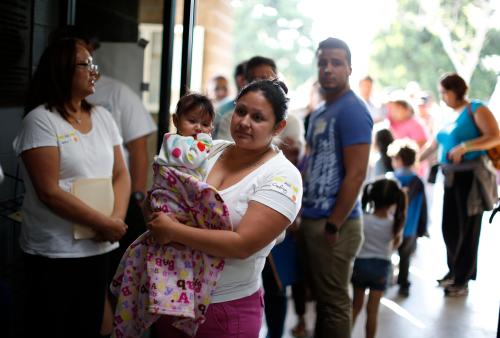For background information on social impact bonds, click here.
The signing of the contracts for the Colombia Workforce Social Impact Bond (SIB) on March 29 marked the launch of the first SIB in a developing country. This SIB will target skills training and employment support to vulnerable, unemployed individuals in Bogotá, Cali, and Pereira. While two Development Impact Bonds (DIBs) have been implemented in Peru and India, a distinguishing feature of a SIB is that the outcome funder is a government entity. In this case, the Colombian Government’s Department of Social Prosperity (Prosperidad Social) will provide a portion of the outcome funds.
What is the social challenge?
While the unemployment rate in Colombia has reduced dramatically from a rate of 16 percent in 2000, it remains high at 9 percent and is even higher among vulnerable populations, such as young people and women, who are more likely to work in Colombia’s large informal sector. Furthermore, significant wage gaps exist for Afro-Colombians and the indigenous population. The armed conflict in Colombia has exacerbated these labor market inequalities, with Colombia having the world’s largest internally displaced population. An estimated one out of two people in extreme poverty is an internally displaced person.
What intervention does the SIB finance and for whom?
The SIB will support a range of employment measures, including skills training, psychosocial support, and intermediation services for job placement and retention for 514 vulnerable individuals. In particular, the intervention will be targeted at high school graduates between 18 and 40 years old, who are not formally employed at the start of the program, who score below 41.74 on SISBEN (a poverty measure), who are registered in Red Unidos (the extreme poor), or who are victims of displacement due to the armed conflict. To be eligible individuals must also not have previously participated in Prosperidad Social’s similar employment programs.
Who are the stakeholders?
The investors in the SIB are a coalition of foundations including Fundación Corona, Fundación Bolivar Davivienda, and Fundación Mario Santo Domingo, who are providing upfront capital to finance the intervention. Fundación Corona serves as the contract manager with several service providers. Prosperidad Social, an entity of the Colombian national government, will provide just under half of the 2.2 billion Colombian pesos (approximately $765,200) in outcome funds. The government of Switzerland will fund the remaining portion through its State Secretariat for Economic Affairs (SECO). The Inter-American Development Bank’s (IDB) Multilateral Investment Fund (MIF) is channeling the outcome funds of SECO, as well as supporting various aspects of the design work. Instiglio, a global non-profit impact bond and results-based financing advisory organization, advised the design of the SIB. Deloitte consulting will provide independent verification of the agreed upon outcome metrics.
What does success look like?
The selection and negotiation of the metrics and payments in impact bond contracts can be complex and depend on a multitude of factors related to goals of the outcome funders and investors, data availability or the ability to measure outputs or outcomes (within the required timeframe), costs of data collection, and contextual factors related to the beneficiary population.
In this SIB, the aim is to employ individuals for whom the chances of gaining and sustaining employment are low. Job placement and job retention for 3 months are the two metrics, each of which represent half of the repayment amount. A bonus payment of 10 percent of the overall price of the two metrics will be made for job retention at 6 months. In the first year of the SIB, Prosperidad Social will repay the investors for job placement and retention of three months, up to 1 billion Colombian pesos, after which repayments will come from the IDB/MIF. In the second year, all payments will come from the IDB/MIF, up to a total of 1.2 billion pesos.
Figure 1: Colombia workforce SIB metrics and payments
 Source: Brookings (based on data provided by Instiglio).
Source: Brookings (based on data provided by Instiglio).
What is interesting about this SIB?
While the global landscape of impact bonds is quite varied in the types of actors playing different roles, the structure of the model, and the size and repayment terms of the transaction, this SIB has some particularly interesting features. To start, as mentioned, this is the first fully contracted impact bond in a developing country for which there is a government outcome funder (note that a set of impact bonds in South Africa will also include government outcome funders but the contracts with the other parties are yet to be signed). Furthermore, it is the first time that a donor government, in this case the Swiss government, provides outcome funding for an impact bond (in the case of the Peru DIB, the outcome funder was an autonomous intergovernmental financial institution and in the case of the first India DIB, the outcome funder was a foundation).
The engagement of the outcome funders for technical assistance to the design phase of the project adds to both the uniqueness and complexity of this deal. Given that this contracting model is new for government, the role of SECO and IDB/MIF provided needed assurance, an ability to seek technical assistance from a third party (Instiglio), and reduced the risk for the government by agreeing to allow government outcome funding to be disbursed first. Furthermore, donor engagement facilitated an extra push on outcome achievement by including a bonus payment of 10 percent of the outcome funding commitment contingent upon job retention after 6 months.
In addition, the use of administrative data from a different government entity (Ministry of Health), which was not engaged in provision of services or outcome payment, marks an extremely creative and original solution to the ever-so-challenging dilemma of data availability in developing countries. Finally, the SIB is notable for its record design time: the design process started in July, and contracts were signed in March. Several years of building up stakeholder awareness and exploring the model were critical to achieving this relatively short timeframe.
The future of impact bonds in developing countries
At present there are around 30 impact bonds being developed across Latin America, Asia, and Africa for issues ranging from health and education to agriculture and economic empowerment. Last November, Brookings, with Convergence and Grand Challenges Canada, brought together about 50 practitioners to discuss their experience developing impact bonds.
We will release a report, based on feedback captured from the event and additional Brookings research and interviews, before summer 2017 (northern hemisphere) capturing lessons learned around five key issues areas:
1) Identifying appropriate interventions and service providers.
2) Engaging outcome funders.
3) Selecting metrics and structuring payment.
4) Developing the operating model, structuring the vehicle, and raising capital.
5) Implementing and measuring impact.
As new actors engage and as the paradigm of social services financing and delivery continues to shift toward results for domestic governments and donors, it will be imperative to continue to capture the learnings and hacks identified by impact bond pioneers to ensure efficiency and effective use of resources.
More on impact bonds available here.







Commentary
Colombia leads the developing world in signing the first social impact bond contracts
March 31, 2017